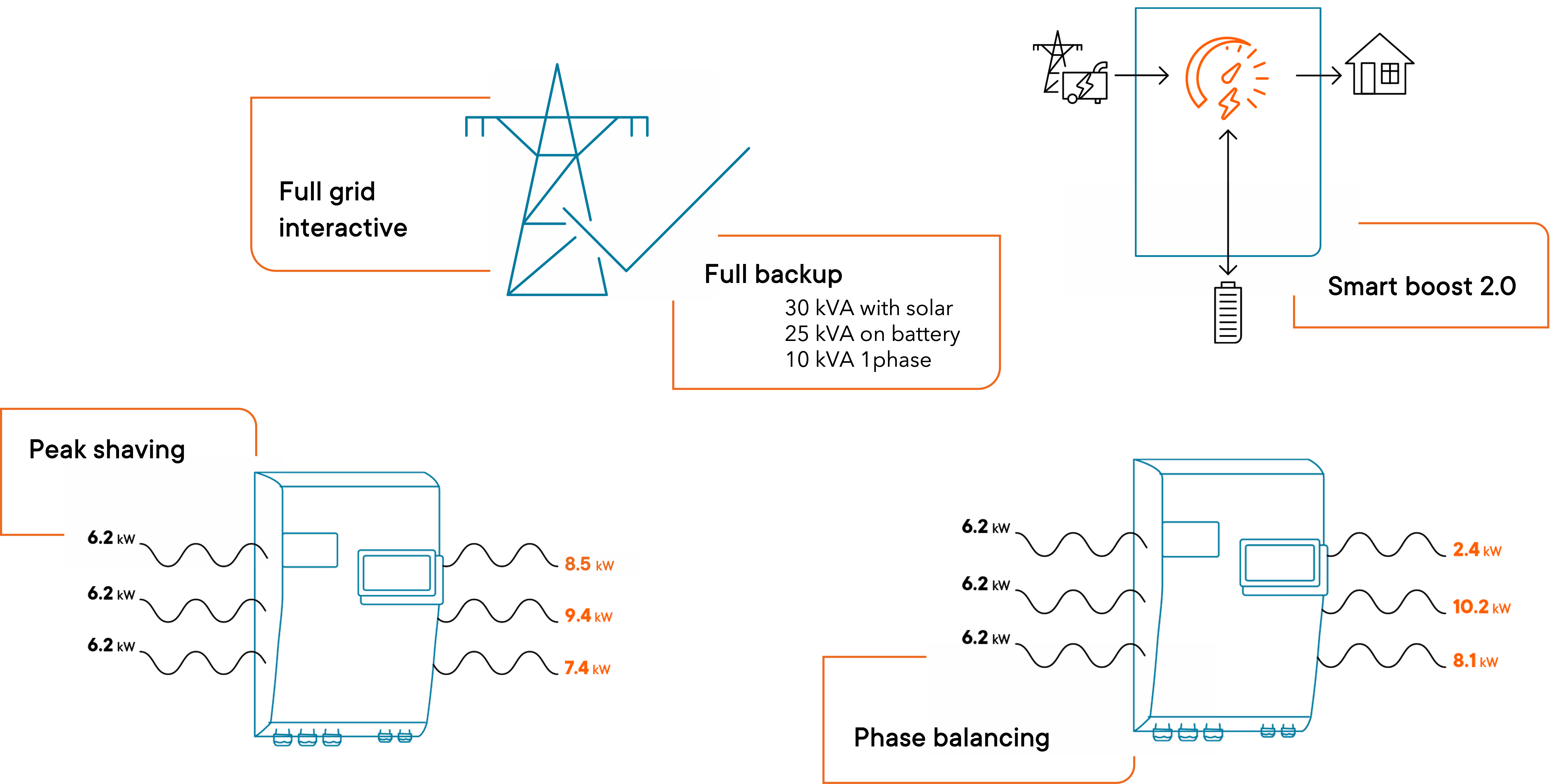Autarky principles
Differences between self consumption and autarky
More than selfconsumption, we offer energy autarky. This autonomy will allow to fully manage your solar energy to provide a reliable supply for the next 20 to 30 years. The energy transition is on its way. Producing one's own renewable energy must become a priority for all those who want to consume energy. At the level of individual housing, solar photovoltaic is a privileged source.
Solar energy means conversion electronics and inverters. With an equipment of the Studer next range you choose a high-tech converter which will play a central role in the energy production of your solar electric installation. The next3 has been designed to work as a solar battery charger and a hybrid inverter operating in both "ongrid" and "offgrid" modes. Its advanced and fully configurable features will ensure that your energy system works perfectly in all situations.
When the next3 is connected to batteries and photovoltaic panels, it automatically recharges the batteries in an optimal way with all available solar energy. Depending on the selected programming, the solar energy can be fed into the grid or used for self-consumption only. The precision of the MPPT (Maximum Power Point Tracking) algorithm, the high efficiency and the low internal consumption ensure an optimal use of the energy produced by the PV modules.

Selfconsumption with storage
Professionals and amateurs are used to qualify the performance of a solar photovoltaic installation with its normalized production per installed kWp (kilowatt-peak) and the selfconsumption rate. The selfconsumption rate is the ratio of what is produced by the solar system and what is consumed directly. This indicator gives an idea of where the solar energy goes: into consumption or back into the power grid. The selfconsumed energy is obtained by subtracting the amount sold to the grid from the total PV production. In fact, the difference is what remains in the house.

The selfconsumption systems are sometimes offering the possibility to add storage as an option, in order to maximise the selfconsumption rate. You can store in the battery some of the excess power before sending it to the grid, and you could then use this stored energy later during the evening.
From self-consumption to autarky
Existing for a long time but less used, the autarky rate indicates to what extent a house is powered by solar energy. The autarky rate really indicates if a prosumer uses his own energy or not, if he really covers his needs or not.
It is not the overall production balance that is important for the selfsufficiency rate, but the actual direct use in the site. If a lot of energy is sold to the grid and bought back later, the house is not independent from the grid. Where your solar energy goes to and come from? Switch the point of view from the production to the consumption for the energy transition.

A step towards full autarky
With PV installed on your home, if there is enough production, you can cover your own consumption during the day. If loads are not covered, energy will be injected from the grid. If you produce excessive power, it will be sold to the grid to optimize costs. With autarky, you add storage to use during the night the energy produced during the day. You don't just optimize your costs, you produce your own energy and can be independent from the grid. Different autarky rates are possible, from partial autarky to full autarky.
To achieve our energy transition goals, our energy must be produced locally and renewable to the maximum. More than using solar energy directly, the majority of our consumption must come from solar energy and for that we must not minimize the installed surface. This is justified by the decrease in the price of solar installations and the additional cost of the additional surface which is less. To have a good autarky (or autonomy) requires in general to use all the roof surface available for solar and to store the temporary surplus.
The solar resource varies with the seasons, but also the consumption (heating, light needs with the length of the days, ...). The critical period for energy will be winter and it is better to have surpluses in summer to better cover its needs the rest of the year.
To do this, it is important not to minimize the amount of solar and use the maximum on the surfaces available. This is especially true with the arrival of electric cars and their home charging. That's why the next3 has two 8kW PV inputs for a total of 16kW. This may seem like a lot compared to the amounts installed in the past on a single-family home, but with the decreasing costs and the need for renewable energy, it is a wise choice.
With a battery, excess solar recharges it during the day and the energy is discharged at night to cover consumption. This optimizes selfconsumption since the surplus does not go back into the grid but it also improves selfsufficiency since indirectly one uses one's own energy during the night. To invest in autonom system means to become not only a consumer but also an actor of the energy strategy of the future. It stabilises the grid and contributes to a cleaner planet.

Internal architecture
Schematic view
The next3 concept, the power flow dispatcher is the brain of the system
In order to better understand how the energy management is done, the following diagram will help to identify the main blocks inside a next3 and how the power flow dispatcher plays a central role.
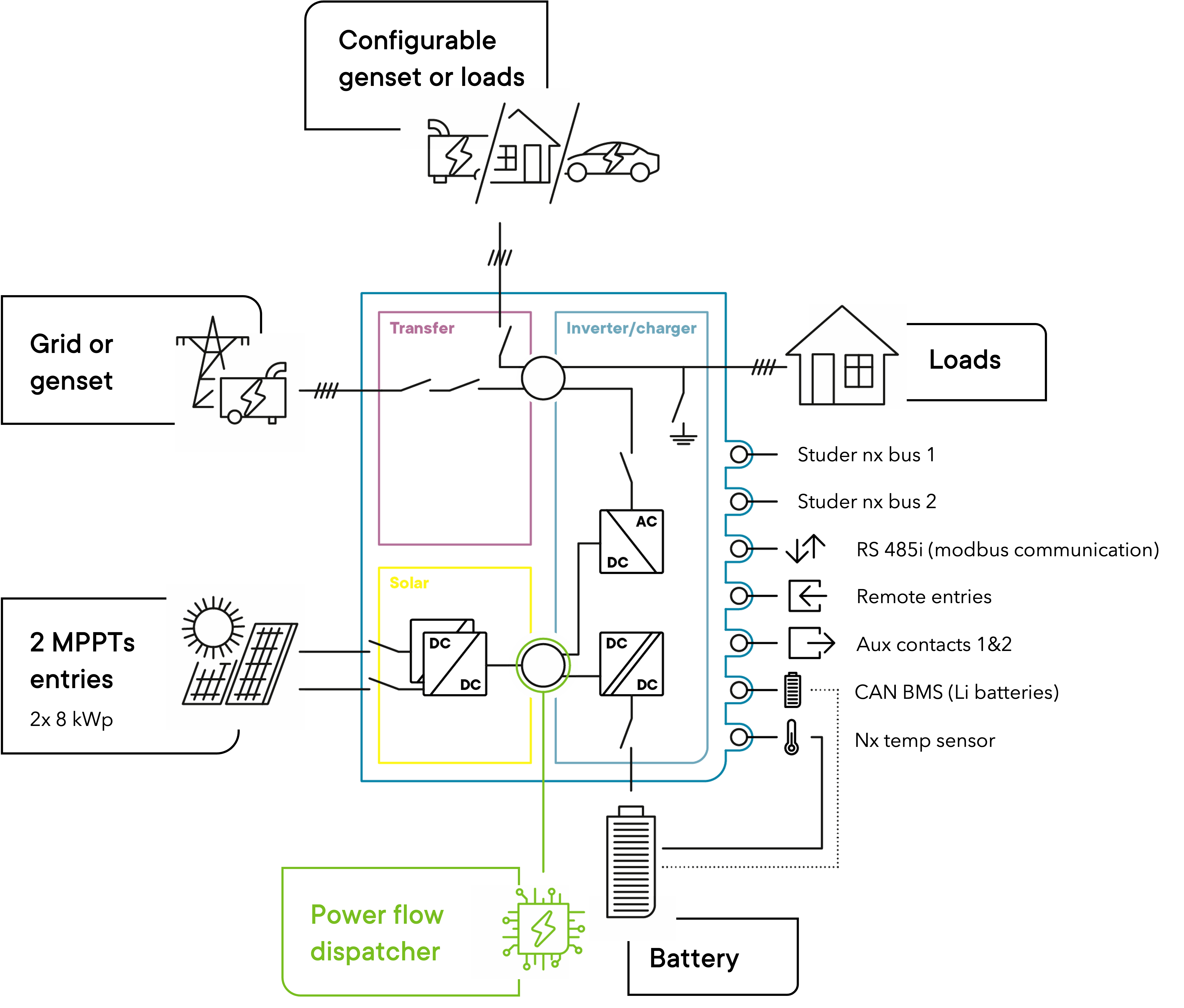
Energy strategies
Beyond self consumption, autarky
Choose among a range of different strategies to configure your device for your offgrid and ongrid applications
Which are the typical applications that we could develop with the next3? The next3 has been conceived considering our more than 35 years of experience in offgrid applications. The next3 is the perfect device for reliable and flexible offgrid applications ensuring a complete autonomy. In addition, with the new AC source incorporating the security features, the anti-islanding and double relay and the control software to comply to all the new LV regulations, the next3 offers the possibility to go beyond selfconsumption. Let us lead you to the solar autarky.

Essentials to know about a next3 system
The next3 is a hybrid inverter charger, that can work in a stand-alone (offgrid) mode or connected to an external AC source, being a grid or a generator.
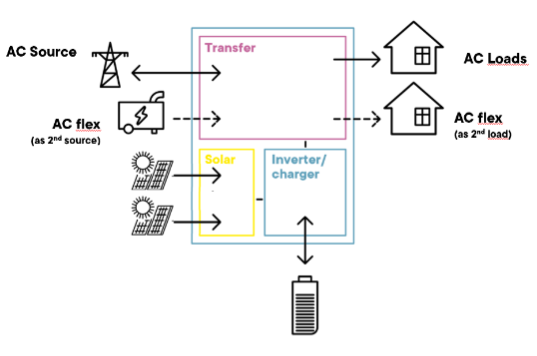
A few concepts must be understood to use and configure the next3 systems properly:
- The next3 has a connection named “AC-Source” where comes the main AC source: the grid or a generator.
-
- This input has a high security level, with doubled security relays for disconnection according to new international grid code and safety standards (for example: IEC 62109, VDE-AR-N 4105, EN 50549-1, ...). In case of connection to a distribution grid, always connect the grid to AC-Source.
- The choice to use AC-source to connect to the grid or to a genset is done during the first configuration of the system. It cannot be change ‘live’, while the system is working, and would need a complete reset of the system if you want to change it. The behaviour of the next3 is different with a grid or with a genset.
- The grid code choice must be set properly by the qualified installer during commissioning according to the local requirements of the DSO (Distribution System Operator). This is done during the wizard process. It can only be changed with a complete reset of the system and restart of the wizard process. The access code “Expert” that enable access to the wizard after the first commissioning is not public for this reason.
- AC-source works with three-phased grid only if a grid code is selected because (all) grid codes ask to have the proper 3 phases for 3-phased systems. Operation on a single phase is not allowed. Operation on a single phase is possible if a genset is selected as source during the wizard.
- There is only one connection to one AC-source in a system even in a multi-unit system when there are physically multiple connections.
-
- Transfers are never used in parallel and only one transfer switch will be operated. That means the max transfer current is 80A even with 3 next3 in parallel.
- The identification of which AC input is used in multi-system is done during the wizard configuration process.
- The next3 is an “offline UPS”, that means the AC main is supplied directly to the load with the internal transfer switch (no double conversion). This implicate that the voltage and frequency of the grid is the same on the loads side.
- On the other side, it has a connection named “AC-Loads” where the load/consumption is connected, that are supplied by the batteries/solar when there is no grid or genes.
-
- There is only one AC-load in a system: in multi-units all the AC-loads output must be electrically connected. All next3 work together to create a single voltage (distribution panel).
- The choice to operate “AC-FLEX” as a connection for a genset as source or for controllable loads is done at first configuration and cannot be changed (like for the AC Source).
-
- Similar to the AC-source, there can only be one AC-Flex as source used in a system.
- In case it is used as source, the priority can be chosen with a system setting: first one valid that comes in, AC-source or AC-flex.
- In multi-unit systems the AC-flex connections must not be wired in parallel. The programming of the AC-flex as load are independent for each next3 (slide left and right on the screen to access each individually). The programming is done for each phase L1, L2 and L3 independently. That means for a multi-unit system with 3 next3, there can be up to 9 single phase controllable loads used.
Understand the general energy strategy
The next3 is a renewable energy friendly converter and always try to optimize the solar in the system. The energy management between all the converters and components of the energy system is done by the Power Flow Dispatcher algorithm. This is at the core of the next system.
Studer simplified the use of its product to be transparent to most of the end -user. Four standard energy strategies are available and can be selected during the configuration process in the wizard with only two questions to answer:
- is grid feeding allowed? This question is asked only if you have selected “grid” as connection to AC-source. If you selected “genset”, the grid feeding is forbidden.
- Is battery used for solar self-consumption optimization? That means the battery is used daily as energy buffer. Solar energy recharges the battery and is used during the night.
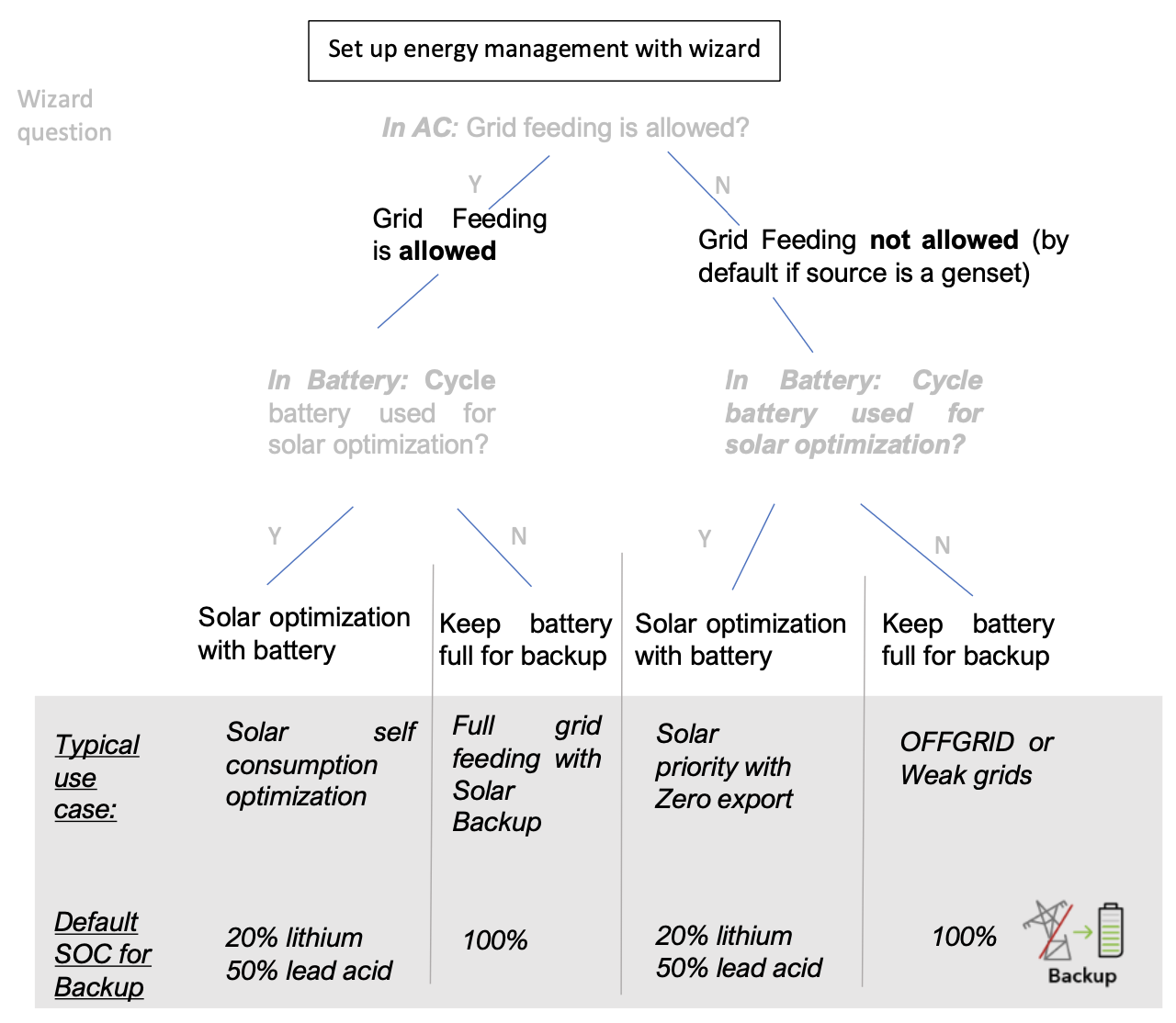
The 4 cases description, defined by those two questions are:
- Use of battery for solarself-consumption optimization until a state of charge (SOC) for Back-Up. During the night, the battery is discharged until the given SOC. Under the defined SOC level, a reserve is left in case of blackout. The default level is 20% to use 80% of the battery as buffer for lithium batteries and 50% for lead acid batteries. During the day, when the solar power is produced, that energy is used to supply the AC loads, charge the battery[1] and inject the excess energy to the grid.
- Full grid feeding: In this situation, the battery is kept full to be ready in case of blackout. The SOC for back-up is 100%. All the solar power produced supply the loads and the excess is injected to the grid.
- Solar prioritywith zero export. The solar power is used to charge the battery and to supply the loads but is never sent back to the AC-source. In that mode the grid-feeding is not allowed. The battery is used as buffer. When there is more solar than loads, the excess will charge the battery. When the loads are higher than the production, the energy is taken first from the battery. Only when it is at the lower threshold (SOC for Backup) the grid will be used. Like that, there is still some energy left in the battery to run some loads when a blackout happens. When the battery is full and the load is small, the MPPTs will reduce the production, causing some solar energy to be lost.
- Offgrid or Weak grid: AC-source is a genset or a grid where the injection is forbidden. The battery is charged to the maximum as soon as the AC source is present ensuring to have energy available in the next blackout event.
Note: in expert mode, it is possible to change the value of the "SOC for backup" setting.
[1] Battery is loaded up to the SOC for grid feeding level. SOC for grid feeding is 100% by default but it can be modified in advanced mode.
All the settings about this general behaviour are set during the “Wizard settings” process. For details about individual settings see the AC-SOURCE section and Battery section of this manual.
Comments about the State Of Charge (SOC) for backup
If the SOC for backup is set to 100%, the battery will be fully charged with the AC-source (when available) with a target voltage following the cycle (for lead acid: absorption, floating, ...) or with the voltage given by the BMS.
If the SOC for backup is lower than 100% the charging may stop before reaching the target voltage of the cycle. Voltage limits of the battery cycles are always used as boundaries in any cases.
SOC for backup is modified in the battery configuration menu and is available to basic user. It is possible to change it at any time.
Standard use cases
Illustrations are provided below for the 4 basic use cases of the next3.
Grid connected installation with grid feeding allowed and use of battery for self-consumption optimization:
Typical answers in the Wizard:
- Grid: YES with grid feeding
- Genset: NO
- Cycle battery: Yes
-
- Default behaviour:
- Optimisation with battery use between 100% (SOC for grid feeding) and 30% (SOC for backup)
- If the grid is connected, the battery is charged only up to 30% with grid energy. Above that level, only the solar is used to fill the battery.
- Solar is used for the loads during the day as soon as SOC is above 30%.
- When battery is full, excess is fed to the grid.
Grid connected installation with full grid feeding; the battery is not cycled (kept for backup only):
Answers in the Wizard:
- Grid: YES with grid feeding
- Genset: NO
- Cycle battery: NO
-
- Default behaviour:
- If the grid is connected, the battery is fully charged to 100% to be ready for a blackout.
- Solar is used for the loads during the day and excess is fed to the grid.
- Next3 is like a grid-inverter when the grid is always on.
This is the configuration of UPS or backup use, with or without solar.
Solar priority without grid feeding: zero export solar backup
Answers in the Wizard:
- Grid: YES without grid feeding
- Genset: NO
- Cycle battery: NO
-
- Default behaviour:
- Energy is never sent back to the grid.
- Solar is used for the loads during the day and to fill the battery, and excess is lost.
OFFGRID installation (back feeding on genset is forbidden!):
Answers in the Wizard:
- Grid: NO
- Genset: YES, on AC-source
- Cycle battery: NO
-
- Default behaviour:
- Energy is never sent back to the genset.
- As soon as the genset is ON, the batteries are charged.
- Solar is used in priority for the loads during the day.
During operation, all the limits and constraints are automatically managed by the NX3. Power production and stroage is optimally dispatched in the system due to the OPFD technology (Optimal Power Flow Dispatcher).
Behaviour in problematic conditions
Thermal behaviour
The next3 is rated at 25° ambient temperature with proper ventilation (space around the next3). It has several internal temperature measurements and performs a derating of its functionalities in case of overheating:
- The solar production is reduced from the maximal current of 20A down to 0A to stabilize the temperature at acceptable level.
- The battery charging and discharging current is reduced to stabilize the temperature.
- The inverter max power is limited:
-
- In islanded mode, the power is directly given by the loads. If the max current is reached, the voltage drops because the inverter cannot supply the load. When the voltage goes under a voltage threshold of nominal power -10%, the inverter goes to overload.
A message indicates if the performances are limited by temperature.
Unique technical features
Ready for autarky!
Our proposal: an offgrid inverter ready for the grid.
What’s a next3? It's a new hybrid inverter charger all-in-one
- 15kW looks a lot, but remember it is nominal power
- Battery inverter from 48V to 3phase AC, compatible with a range of different batteries technologies including lead-acid and lithium
- 2 Built-in MPPT solar inputs
- Integrated transfer module with a 3 phase AC source, with security anti-islanding for grid applications according to the latest LV regulations
- A unique AC flex interface configurable as 2 nd source or 2 nd load for smart energy strategies
- A completely new comprehensive user interface for configuration, follow-up, monitoring and communication
- A wide range of integrated features: CAN BMS and RS485, battery temperature, fully configurable remote entries and auxiliary contacts, and many more.
.
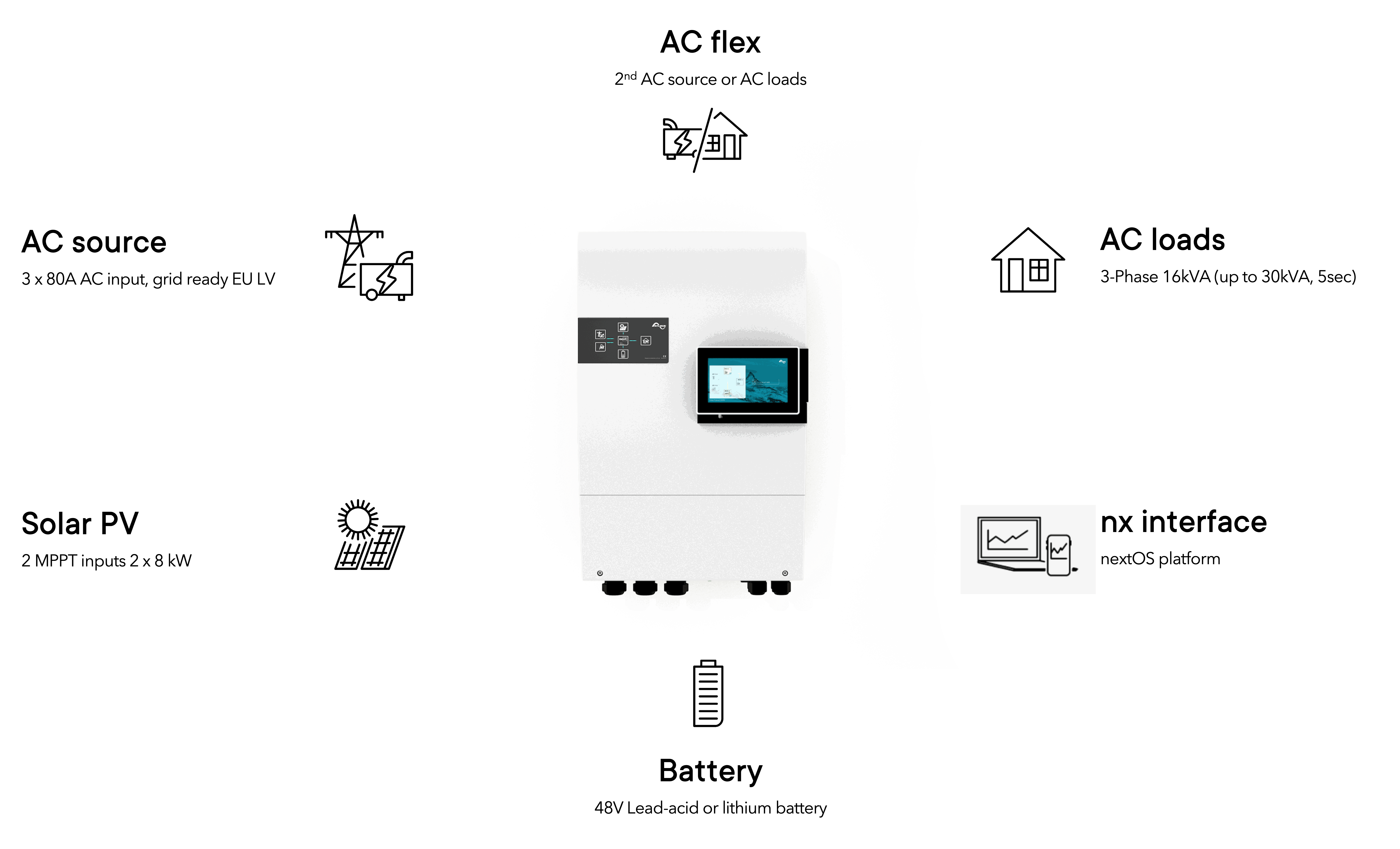
The power flow dispatcher, the innovative and patented brain of the system

An optimisation control algorithm with ultra fast reactions
High voltage DC link for robustness and autonomy
High conversion efficiencies from solar to loads and from solar to grid
AC flex, a unique and versatile AC interface
Configure the AC flex as a second AC input or second AC output.
As a second input can be used to centralise the management of grid and backup generator or even two different generators in an offgrid application. As a second output you can have a completely automatic and fully monitored load, for electric mobility, secured loads, and other applications.
6 arguments for professional installers
The next3 is the best tool for professional integrators and installers.
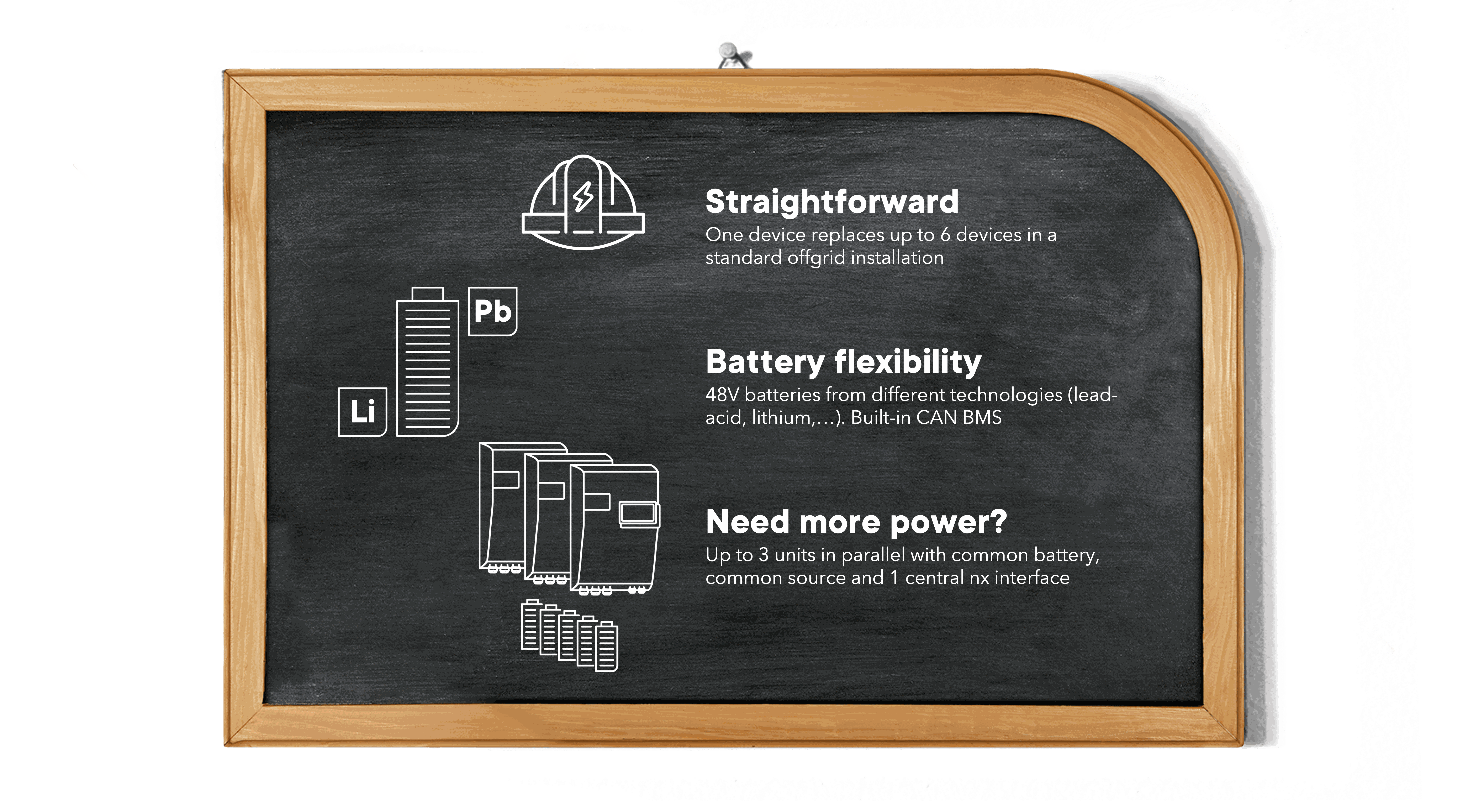
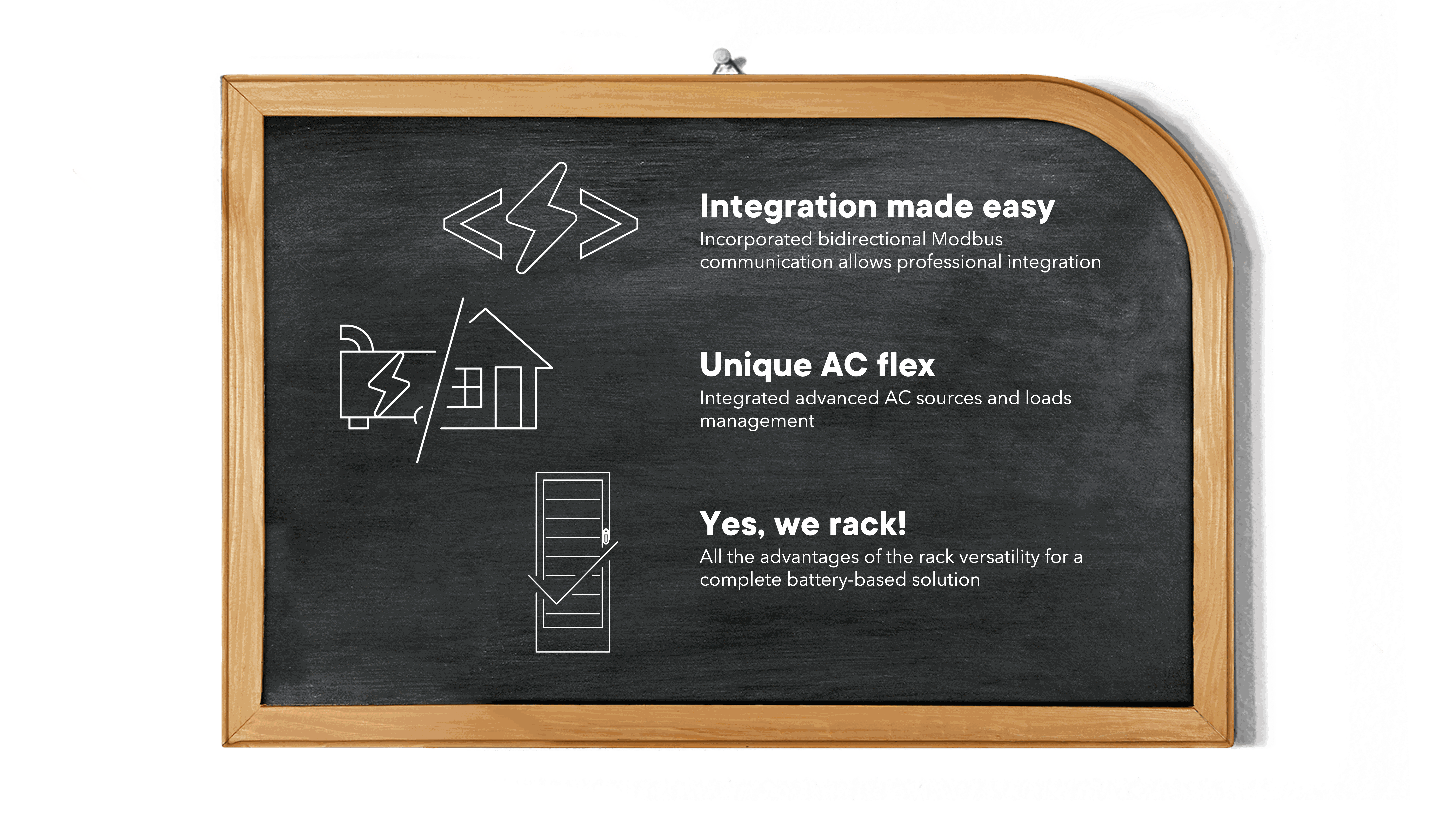
Fully grid interactive with special functions
The next3 is not only an offgrid inverter for grid-tied applications. Future grid servicies could be envisaged, there are no limits.
